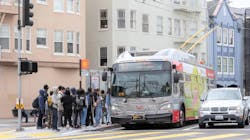MTC releases Survive & Thrive report Bay Area transit
The Metropolitan Transportation Commission (MTC), in partnership with Bay Area transit agencies, business groups and transportation advocacy organizations, released a new report that outlines steps that need to be taken over the next decade by MTC, transit agencies and the state government to help the region’s transit network avert a near-term fiscal collapse and adapt to post-pandemic travel patterns transition to a new business model by the latter half of the 2020s and expand its reach and capacity in the 2030s.
The new report, titled, "Survive & Thrive: Roadmap to a Sustainable Business Model for Bay Area Public Transit”, builds on the Transit Transformation Action Plan released in 2021 and spotlights a successful shift to this self-sustaining business model as the central goal of the transit transformation process.
The report addresses accountability, acknowledging many Bay Area transit agencies’ business model for the next few years will remain dependent on short-term relief funds to help offset the pandemic-induced loss of fare income. To avoid the ‘death spiral’ that occurs when a scarcity of money drives service cuts, resulting in further ridership loss and further service cuts, transit agencies must maintain reasonable service frequencies across key routes. They also must improve the customer experience by making transit fast, frequent and reliable and allay residents’ concerns about safety and security.
The new report asserts that by 2026, the transition to a new business model for Bay Area transit will be underway, and transit will have regained some of its pre-pandemic market share as new travel patterns stabilize and as customer-facing improvements are implemented and reach scale. Fare revenues and the system’s capacity to self-fund a portion of its operating costs will grow but likely will remain well below 2019 levels. This is expected to require new sources of public support — from voter approval of a new regional tax measure, new sources of local funding, potentially supplemented by new, ongoing state or federal assistance.
By 2030, the report projects the new business model for Bay Area transit largely will be in place, and ridership will grow as new and improved transit services that are currently under development come online and as policies concentrating housing and commercial growth near transit reach maturity and scale. As the 2030s-era business model puts more emphasis on expanding transit’s reach and capacity, transit agencies will have to ensure that costs remain in alignment with revenue.
The ‘Survive & Thrive’ paper is designed as a living document that will be regularly updated to incorporate new ideas and feedback. MTC’s partners in development of the report include AC Transit, Bay Area Rapid Transit, San Francisco Municipal Transportation Agency and San Francisco Water Emergency Transportation Authority; the Bay Area Council and the Silicon Valley Leadership Group and Seamless Bay Area, SPUR and TransForm.
